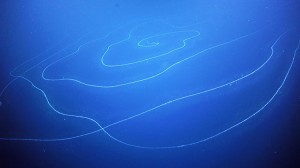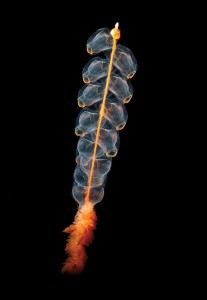Giant Sea Monster Spotted in the Australian Deep

A giant siphonophore, seen in this image as a glowing swirl, was discovered in the deep sea off the coast of Western Australia in 2020. Researchers estimated the siphonophore’s length at 150 feet (45 meters).
Photo credit: Schmidt Ocean Institute
What’s the longest creature ever spotted in the oceans? If you answered “blue whale,” you’re probably in good company. After all, these giants of the deep can reach 100 feet (30 meters) in length. But in April, scientists using a remote-piloted submarine off the coast of Western Australia spotted a living thing over half again as long! The creature was a ropelike siphonophore estimated at 150 feet (45 meters) in length. The scientists were from the Western Australian Museum and the Schmidt Ocean Institute. They spotted the creature at a depth of about 2,000 feet (600 meters).
It gets even weirder—siphonophores are among the strangest animals found in the oceans. A siphonophore is not a single living thing. Rather, it is a colony of individual organisms, called zooids << ZOH oydz >> , arranged in a long string. All the zooids descend from a single initial zooid. Within the colony, each zooid serves a specialized function, such as movement, digestion, or reproduction. The body of the colony is jellylike and fragile, and individual zooids may easily become separated. However, a zooid cannot survive in separation from the colony. Siphonophores challenge traditional ideas about what it means to be an individual. Each zooid is a distinct organism, a clone of the original zooid. However, the entire colony functions much like a single living thing.
Siphonophores feed on crustaceans (shellfish), tiny fish, and other small animals. They capture their prey by trailing long tentacles. The tentacles contain stinging capsules called nematocysts. The nematocysts harpoon prey and inject a toxin, immobilizing it. Many siphonophores simply wait for prey to swim into their tentacles. At least one deep sea species has been found to lure its prey with light.
Siphonophores reproduce sexually through the use of specialized zooids. In some species, the entire colony functions as either male or female. Colonies of other species have both male and female parts. A new siphonophore begins with a single zooid formed from a fertilized egg. This zooid produces the rest of the colony through budding. Budding is a form of asexual reproduction in which a new organism grows from a bud on the original organism.



